 Needs Pictures: 0
Needs Pictures: 0
 Picture(s) thanks: 0
Picture(s) thanks: 0
Results 31 to 45 of 74
Thread: Veritas planes
-
21st September 2014, 05:43 PM #31
 Hi IanBut possibly, the more important variable is the actual angle of the chip-breaker where it meets the upper surface of the cutter. On standard Bailey combos, the rolled-over end meets the blade at a pretty steep angle. It varies quite a bit between my planes (either because of manufacturing variance or subsequent attempts at getting them to fit properly), but I would estimate they are all greater than 75 degrees at the point where they actually meet the cutter surface. Since this angle is likely to have a big impact on how much & how easily the shaving gets turned, could this be a key factor???
Hi IanBut possibly, the more important variable is the actual angle of the chip-breaker where it meets the upper surface of the cutter. On standard Bailey combos, the rolled-over end meets the blade at a pretty steep angle. It varies quite a bit between my planes (either because of manufacturing variance or subsequent attempts at getting them to fit properly), but I would estimate they are all greater than 75 degrees at the point where they actually meet the cutter surface. Since this angle is likely to have a big impact on how much & how easily the shaving gets turned, could this be a key factor???
I have spent time experimenting with angles at the leading edge of chip breakers. I am not claiming a definitive rule to follow, but so far I find that there is a specific range one should aim to have. Essentially, as the bed angle increases, so the leading edge angle decreases. What we are aiming for is a similar angle at which the shaving is bend at the blade. For example, a 45 degree frog works well with a 45 degree leading edge angle to the chip breaker; a 50 degree frog/bed would be better with a 40-45 degree leading edge; and a 55 degree frog/bed could be fitted with about a 35 degree leading edge. The leading edge for the 55 degree LN #3 I used has a 30 degree leading edge.
Note that the Stanley chip breaker has a rounded 45 degree LE, while those from LN and LV are 25 degrees and require a secondary bevel.
Now there is also the factor of the distance of the leading edge of the chip breaker to the edge of the blade. There is an optimal distance - too close and the plane will not cut (tends to create crinkly shavings and is hard to push), and too far back (1/32" is too far back) nothing happens. About two years ago I posted results of my experiments with distances from the leading edge of the blade (in fractions of a mm). This was not intended to create a rule, but rather to explore differences. There is no doubt that this is a fiddly method to learn. There is also no doubt that it works. However, there are also other methods that may be used to prevent tear out, such as a high cutting angle (whether via a BU or BD plane), and a closed mouth with a finer shaving thickness.BUT, if I move the cap-iron too close to the edge on most of my planes, I get decidedly inferior performance. I have fitted all my cap-irons as close to perfect as I can get them, and polished their leading edges, but if I reduce the gap too much, all I get are crinkled shavings and very poor cutting. Pull it back to slightly more than a 1/32nd", & all is well. This has been my experience all my woodworking life.
The relevance of this discussion occurs in this thread is that it relates to the reason for the chip breaker in the new LV planes. If planning to use the chip breaker, you may also need to add a secondary bevel to the one you have on your plane, and its LE angle will need to be chosen with your bed angle in mind.
Hiroller, ironically, on US forums, where a few posters do the chip breaker thing to death, I am inclined to jump in and say that there are other, easier methods (such as a high cutting angle on a BU or BD plane and a back bevel on a BD plane ..). The response is that the lower bed of a basic Stanley (45 degrees) should enable the resulting surface to be smoother than from a plane with a higher bed (which is moving in the direction of a scraping cut). In my experience this is true, however it is also mostly irrelevant unless you are not planning to add a finish to the wood. As soon as a finish goes on, then the higher polish disappears.I've watched the video a few times now. There are three points that stand out to me.
1. They prove that a chip breaker can be used to advantage but it is not necessary - as they achieved exactly the same performance against the grain, without a chip breaker, by setting the shaving to half the thickness.
2. They don't consider the impact of having a tight mouth. There is plenty of evidence for the benefit of a tight mouth with very fine shavings for preventing tear out on a smoothing plane.
3. The don't consider various blade angles. There is enough variation of their results in the small changes that they tested to believe that increasing blade angle may have similar impact to the use of a tight chip breaker.
In summary, they prove that a well set up chip breaker can deliver great performance but to me, they don't prove that it's the only way.
Regards from Perth
DerekVisit www.inthewoodshop.com for tutorials on constructing handtools, handtool reviews, and my trials and tribulations with furniture builds.
-
21st September 2014 05:43 PM # ADSGoogle Adsense Advertisement
- Join Date
- Always
- Location
- Advertising world
- Posts
- Many
-
22nd September 2014, 07:49 PM #32

Ian
with all the variables mentioned in this discussion, there does not appear to be any mention of technique. Would that be a factor? Especially if a user adjusts their push stroke to compensate for the way they adjust their cap iron.
TTLearning to make big bits of wood smaller......
-
22nd September 2014, 08:45 PM #33

TT
Can you explain "Especially if a user adjusts their push stroke to compensate for the way they adjust their cap iron."?
Regards from Perth
DerekVisit www.inthewoodshop.com for tutorials on constructing handtools, handtool reviews, and my trials and tribulations with furniture builds.
-
22nd September 2014, 09:23 PM #34

That does sound vague. What I was getting at was if I adjust the cap iron/chip breaker to what I think works, I will get a result because Iv'e adapted my stance and stroke to make it work. if you were to used the plane you may not get a result because you have adapted your to your own settings and vice versa.
TTLearning to make big bits of wood smaller......
-
22nd September 2014, 09:48 PM #35
 Deceased
Deceased











- Join Date
- May 2008
- Location
- Australia
- Posts
- 2,357

The Veritas Bevel Up Smoother Plane Low dont use a cap iron (chip iron for those that wish to use the term).
As you will see from the following attachment; by utilizing a higher primary bevel angle such as of 38* & 50*, the effective cutting angle increases to a high range of 50*, & 62*. Near identical to that of the traditional York Pitch (50*) and Half Pitch (60*) for bevel down planes.
http://www.veritastools.com/products/Page.aspx?p=93
http://www.handplane.com/45/perfect-...les-explained/
Stewie;
-
22nd September 2014, 10:50 PM #36

Hi TT
I took a few more photos, which will add to the information, and I will use to respond to your observation/question (not sure which it is).
Returning to the interlocked section of Fiddleback Jarrah, the LN#3 (with 55 degree frog) planed into the grain again. This time the chip breaker was pulled back to 1/16", where it was out of the way. In part this was to test the belief held by Stewie (Planemaker) that the high bed/frog (i.e. cutting angle) was responsible for the earlier results.
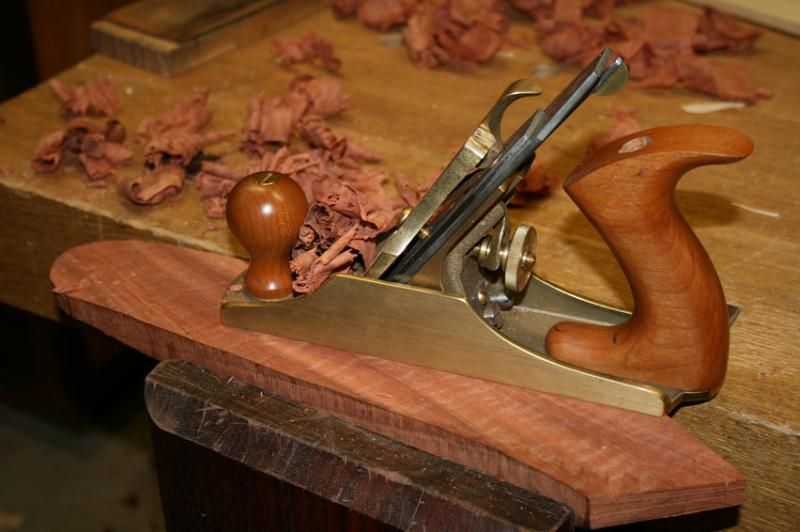
You can see the change in the shape of the shavings. They are no longer straight but curly.
A close up of the surface reveals tearout throughout - not nearly as good as when the chip breaker was also used with this plane ...
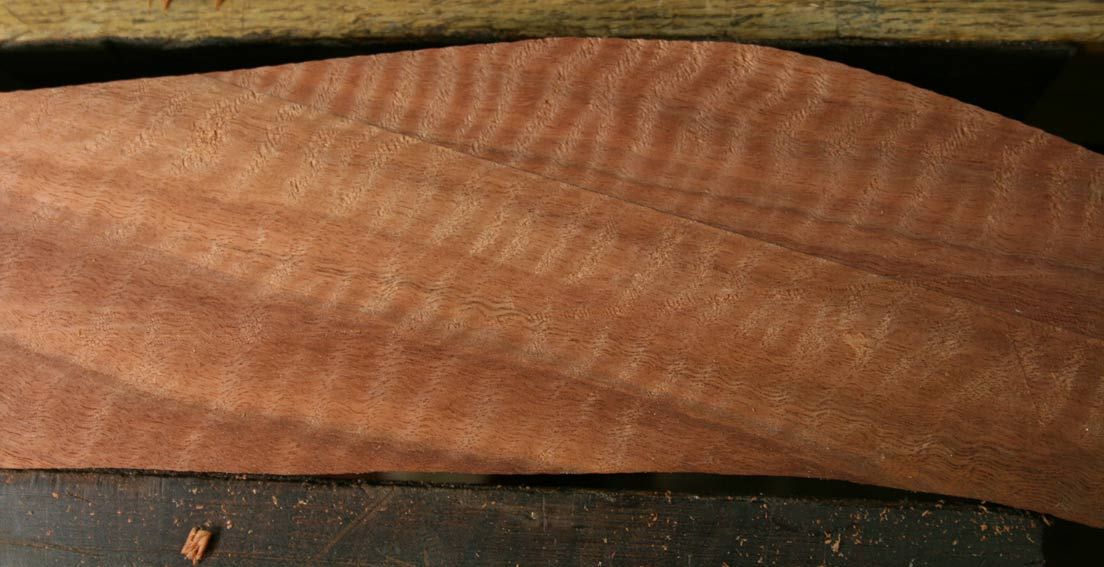
Now I switch to another #3, a Stanley with a LV PM-V11 blade and LV chipbreaker. The leading edge now has a 45 degree secondary bevel and is placed about .3mm from the edge of the blade.
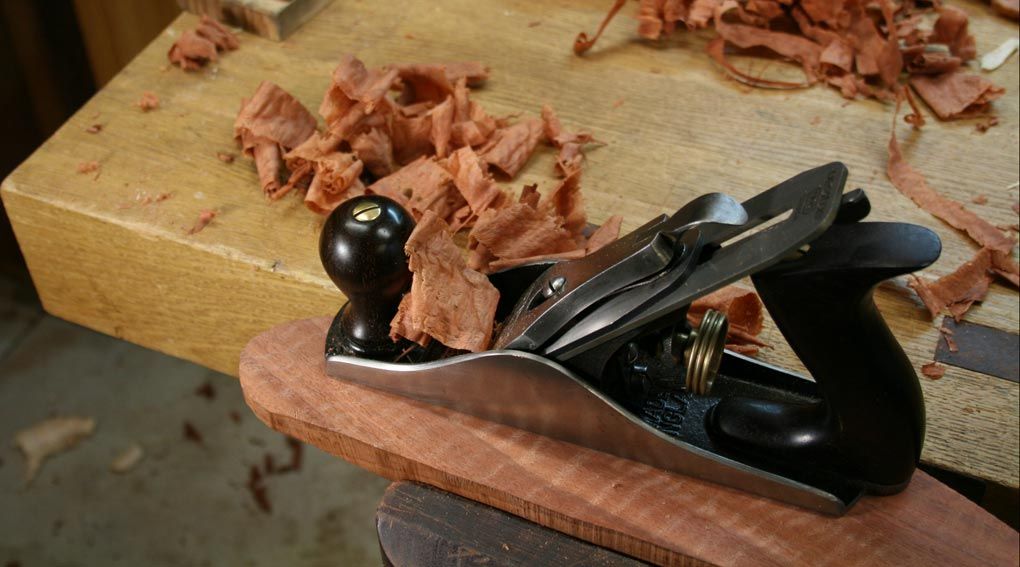
Note how flat/straight are the shavings ...
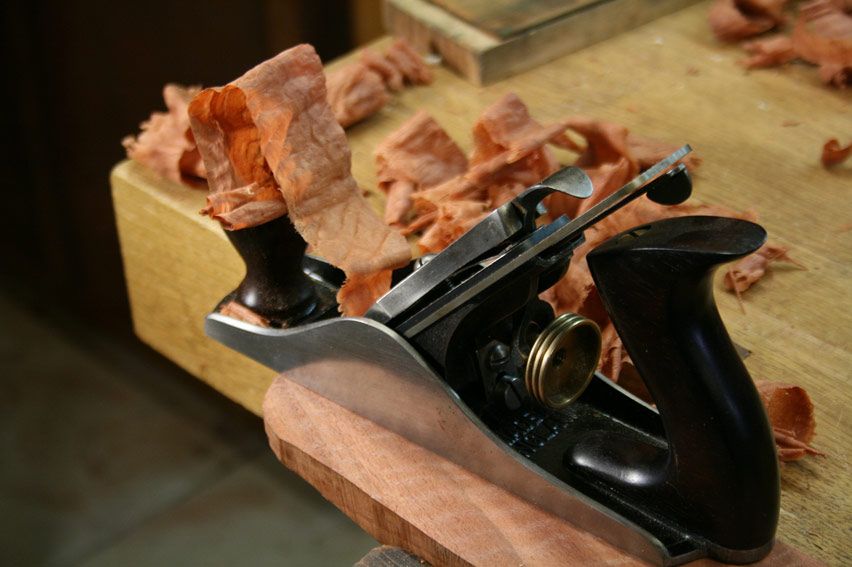
What of the surface quality?
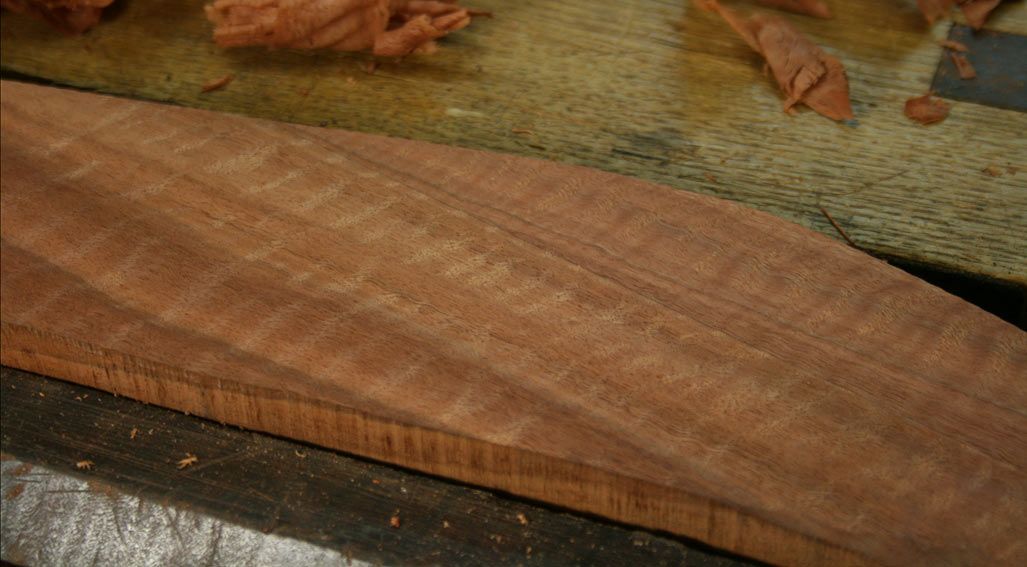
Well, it is not as good as the LN with 55 degree frog and closed up chipbreaker, but it is a whole lot better than the LN with the chipbreaker pulled back
The lower angle Stanley is easier to push than the higher angle LN. However the difference would be negligible with waxed soles.
The other factor is that the cutting angle does make a difference, and is additive to the chip breaker effect - which is something I have been banging on about for the past few years. There is no doubt that both have an effect, and that the effects can be additive.
Regards from Perth
DerekVisit www.inthewoodshop.com for tutorials on constructing handtools, handtool reviews, and my trials and tribulations with furniture builds.
-
22nd September 2014, 11:54 PM #37

Hi Derek
I guess I was guilty of musing. This was the comment Ian made
"This subject has come up numerous times, now, & there is something missing that prevents us from a resolution."
That set my mind to wondering if technique was the missing link.
TTLearning to make big bits of wood smaller......
-
23rd September 2014, 12:10 AM #38

Hi TT
Ian needs to qualify his statement. I cannot second-guess his meaning.
The question is "what is the technique involved?".
Would you like to offer a thought or two?
Regards from Perth
DerekVisit www.inthewoodshop.com for tutorials on constructing handtools, handtool reviews, and my trials and tribulations with furniture builds.
-
23rd September 2014, 12:15 AM #39
 Deceased
Deceased











- Join Date
- May 2008
- Location
- Australia
- Posts
- 2,357

Hi Derek. Its would seem that Veritas Tools Inc., based in Ottawa, Canada, the manufacturing arm of Lee Valley Tools Ltd, dont take your views too seriously on the all importance of the cap iron. They have been trending in a different direction relying more on a higher pitch angle and a tightly set mouth to better control the issues of tear out.
My apologies for being too the point.
regards Stewie.
-
23rd September 2014, 01:01 AM #40
-
23rd September 2014, 01:01 PM #41

Apologies for my intermittent participation in this discussion, but I've been travelling, with very limited internet access. Home now.....
Derek, what I said was a bit cryptic, no doubt. It simply strikes me that there are several known variables affecting the quality of the planed surface, and since these vary widely from plane to plane, and person to person, you would need some elaborate trials to control for each of these. TT's comment on technique is valid, too - for eg, some use a plane 'straight', while others routinely use them 'angled', and that can change the effect quite a bit, as you have expounded on in the past. And one of the most important variables of all is actual blade sharpness, which we know is very variable! It is probably impossible to come up with prescriptions that are going to suit every situation.
You've shown conclusively enough that in your hands & under your conditions, the cap-iron can do more than simply pre-tension the blade. I hope I've conceded that sufficiently already. But though I've fiddled with the setting of cap irons, often, setting closer than about 0.5mm just will not work for me. This may be due to my incompetence, or differences in our tools, or the woods we regularly work with, or all of the above. Some woods, like very recalcitrant Camphor, respond best in my hands, to a plain old 45 degree, BD plane, with cap iron set somewhere around 1/32", which is close enough to 0.8mmm and a long way from the 0.3mm that worked on your Jarrah sample. A very sharp blade is essential, of course. But the same setup doesn't work nearly as well on some other woods I work with, which require higher cutting angles or even scraper planes to produce a tolerable surface.
But though I've fiddled with the setting of cap irons, often, setting closer than about 0.5mm just will not work for me. This may be due to my incompetence, or differences in our tools, or the woods we regularly work with, or all of the above. Some woods, like very recalcitrant Camphor, respond best in my hands, to a plain old 45 degree, BD plane, with cap iron set somewhere around 1/32", which is close enough to 0.8mmm and a long way from the 0.3mm that worked on your Jarrah sample. A very sharp blade is essential, of course. But the same setup doesn't work nearly as well on some other woods I work with, which require higher cutting angles or even scraper planes to produce a tolerable surface.
I would genuinely like to know why I can't get an ultra-close-set cap iron to work, which is why I suggested a couple of possibilities. The most likely candidate, from what you've said (& something I suspected), is the angle at which the chip-breaker meets the back of the cutter, since that will affect the actual turning moment on the shaving. When I get some time for fiddling, I'm going to explore this further - who knows, there may be a eureka moment and another convert to ultra-fine cap-iron settings coming.....
BTW - I don't want to start a fierce debate, but I suggest we can use the name 'cap-iron' quite accurately as a generic term. That doesn't preclude its function as a chip-breaker, when it is doing that, it's just a name for a part. In 99% of the planes operating throughout the country, including my own, it probably isn't doing more than acting as a dampener.....
Cheers,IW
-
23rd September 2014, 05:29 PM #42

Hi Ian
Thanks for the reply.
It may be helpful to this discussion to recall the context of the information about chip breaker placement ("cap iron" has a different connotation). The context is that the new LV bevel down planes have a chip breaker, and this is there to aid in planing squirrelly grain. In the few years between conceiving the idea for a modular plane and its production, the chip breaker has become understood as another way of controlling tear out , and hence it was included in the design.
The new LV planes are all about options and flexibility. They enable one to act on a preference for controlling tearout with a high angle bed, adding a back bevel to increase the cutting angle, or using the chip breaker to extend the existing performance level. There is also the option of using a bevel down plane in place of these. Lots of options. All good.
It is not just about a plane. It is also about technique - sharpening a blade is relevant, pushing the plane at a skew (as you mentioned), pushing smoothly, reading the grain, changing direction ... a good plane cannot always overcome poor technique.
I find it interesting how different the various fora are on the sides of our pond. In the USA many are switching on to the chip breaker - I think that this is partly because they do not have the complex timber we have, and because Stanley planes, which are so cheap and plentiful, can manage better than we do here in Oz. We seem more frequently to support higher cutting angles than they do in the USA. I tend to cop some flack on the US fora for stating that the chip breaker does not work as well as a high cutting angle on some of the woods I use. And here I am copping some flack for suggesting that setting the chip breaker is useful! Actually, all I have attempted to show is that they are both useful.
Actually, all I have attempted to show is that they are both useful.
With regard the difficulty you find in obtaining reliable results from a set up chip breaker, your words simply echo those of mine on US fora. It is a fiddly process at the start. There are three factors that I think make it less reliable - I am still testing this out so this reflects my thoughts: the first is that there is an appropriate angle for the leading edge. Too high and the plane can stop cutting, and too low and the chip breaker does not work at all. Secondly, there is an optimal distance from the edge of the blade. It is closer than you think, and the range is narrow. 1/32" is too far back from the edge. Thirdly, I was adding a micro bevel to the leading edge and this did not work. Now I am adding a wider secondary bevel, and the results are better.
All the above is really an aside. I am not abandoning my BU planes. I am not abandoning my BD planes. I simply seek to understand what works, and why ... and then apply this to furniture making. After all, that is what woodworking is about for me.
Regards from Perth
DerekVisit www.inthewoodshop.com for tutorials on constructing handtools, handtool reviews, and my trials and tribulations with furniture builds.
-
23rd September 2014, 07:13 PM #43
 Member
Member











- Join Date
- Jun 2009
- Location
- Holland
- Posts
- 72

Derek drew my attention to this thread. I am not a regular overhere, but I do peek in from time to time.
Last year I did a bunch of research to the technical side of capirons and high cutting angles. When you are interested in how tehse things work, feel free to have a look at these two articles:
http://planetuning.infillplane.com/h...s_van_der.html
http://planetuning.infillplane.com/h...pbreakers.html
I have no idea what LV is up to, but I think it's great that their new line of planes is a double iron BD design. Now I really hope they put some effort into educating the masses how to use the capiron.
-
23rd September 2014, 07:15 PM #44

Agreed! Anything that makes the process more efficient & enjoyable is good. I would like to sort this out, too.
I am thinking I should make a couple of cap irons and muck about with the the contact end until I crack the secret code (angle). My working hypothesis is that the angle the end of the cap-iron makes relative to the wood surface will turn out to be constant, i.e. it will become more acute as the pitch of the blade increases (at least for a given wood type). I've got planes with 3 different bed angles, so could test my theory to some extent. Of course it will take a fair bit of time, which I am rather short of right now, so I will be more than happy if you or someone else sorts it out in the meantime.....
Cheers,IW
-
23rd September 2014, 08:46 PM #45

Hmm - looks like Corneel has already done more or less what I was planning to do. A fair bit to digest & contemplate there, Corneel - thanks!
Cheers,IW
Similar Threads
-
Veritas Planes
By peter_ashton in forum WOODWORK - GENERALReplies: 21Last Post: 1st September 2011, 10:09 AM -
Veritas Skew Rabbet Planes
By John Saxton in forum HAND TOOLS - UNPOWEREDReplies: 21Last Post: 8th September 2009, 09:47 PM -
Are Veritas planes any good?
By Peter57 in forum HAND TOOLS - UNPOWEREDReplies: 9Last Post: 30th March 2007, 07:20 PM



 Thanks:
Thanks:  Likes:
Likes: 
 Reply With Quote
Reply With Quote

